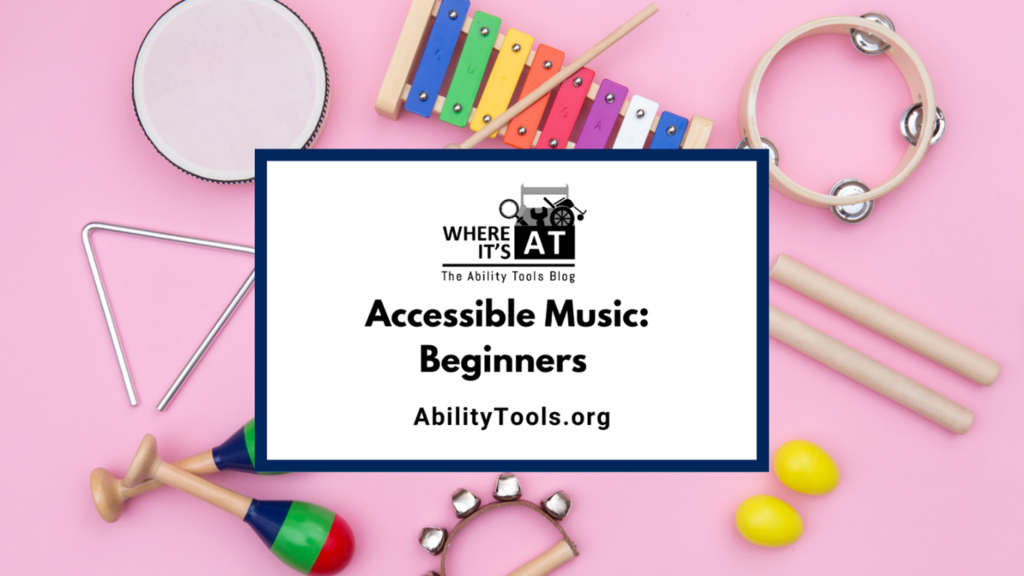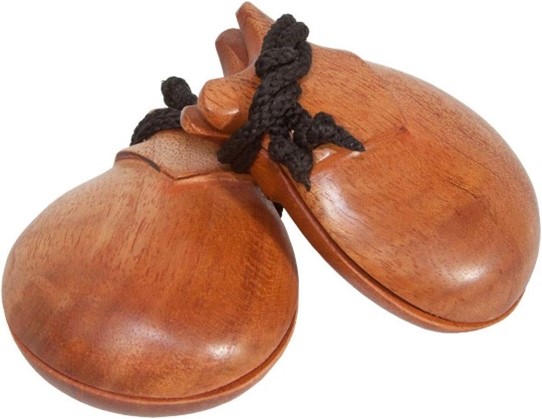When music enters your life, whether you are listening to or playing an instrument, it can’t be denied that the power it creates is unlike any other. Whether used for recreational or therapeutic purposes, having musical instruments available opens doors for everyone. In the first of this two-part blog series, we are going to focus on musical instruments designed to get people started on their musical journey that are either accessible from the start or can be adapted to support the needs of most any musician.

Handheld rhythm instruments
We can start with Cabasas, plastic finger castanets, egg shakers, and ocean drums. All of these instruments can either be utilized out of the box by those with grip-related disabilities, or can be adapted with a variety of AT like the EaZyHold Universal Cuff, grip gloves, or, for an even more custom fit, adapting a pair of gloves and the instrument with hook and loop strips to make lighter-weight instruments grip-free. These are great beginning instruments, because learning rhythm with small instruments like these not only helps with learning percussion, but also the development of more advanced hand movements.
Do-It-Yourself Music Shakers!
If you are crafty and creative, create your own shakers! All you need are toilet paper rolls, painter’s tape and a variety of dry goods such as small pasta, popcorn kernels, or pinto beans. First, cover one end of the toilet paper roll completely with the tape. Next, add one to two tablespoons of dry goods into the roll. Last, seal the other side of your roll with tape. Give it a few shakes to make sure your tape is secure and then get to making music! You can decorate them with markers, paint or stickers and create a range of sounds by making rolls with different dry goods.
Alternative options!
- Take a piece of aluminum foil, scrunch it down to make a rough snake shape and insert it into the tube along with your dry goods to create a rain stick!
- If you need something more durable or that has a more ergonomic shape, you can use fillable plastic eggs, just fill eggs halfway with your dry goods and glue the egg shut.
Switch adapted musical instruments
Most instruments such as drums, bells and keyboards are designed to be played using rapid hand movement using either your palms, sticks or mallets. If pressing keys on a keyboard or holding drumsticks to hit a snare is challenging, using switches could be your solution.
Switches are devices that support with items that require physical interaction. A switch bypasses the original method of interaction, making items that might otherwise be difficult to interact with accessible through the switch. Switches can be any size button for pressing, can be a mouth-controlled straw-like device utilized through sipping, puffing and lip-controlled joystick or even activated through only touch, eliminating pressing force. Switches can be set on a table or the floor, mounted to a wheelchair or any other object, or even worn.
The thing is, switches are already widespread in the music community, guitarists use effects pedals to switch between different tones they want their guitar to emit and drummers use pedals to activate their hi-hats and kick pedals to activate their bass drum. Switches can be found so robustly throughout musical spaces, that using them to make instruments not typically activated by a switch more accessible, really makes so much sense.
The Arcana Strum Adaptive Musical Instrument gets people started learning guitar and music theory. The key and strum handle design replicates the motions of playing a guitar, while being massively modular to allow for support for a wide range of adaptive needs. You can customize the Arcana Strum with a variety of handles that support use with hands, feet, wrists and external switches to replace the smaller buttons on the keyboard.
Accessible apps
The Adaptive Use Musical Instruments (AUMI) project offers software that enables users to play music by tracking head movement, making this app an ideal musical instrument for those whose range of motion is primarily centered around neck and head movement. The developers describe AUMI as “…an entry to improvisation rather than “hitting the right notes” or playing set pieces of music.” The AUMI app is simple in design, making it a great entry point for new musicians. Users can download the free AUMI app in the apple store to try it out for themselves.
Wind instruments
There are a wide range of accessible instruments accessible to play in the woodwind family. For beginning flute players, let’s look at the Nuvo TooT with silicone keys. The use of silicone finger hole covers supports with covering the finger holes that determine the tone of the instrument, a fantastic advantage if someone is building their fine motor skills. The Nuvo TooT comes with a typical flute lip plate and also an adaptive lip plate named the FirstNote. The FirstNote lip plate helps the instrument catch the air flow from the musicians breath, providing support to produce the desired tone.








